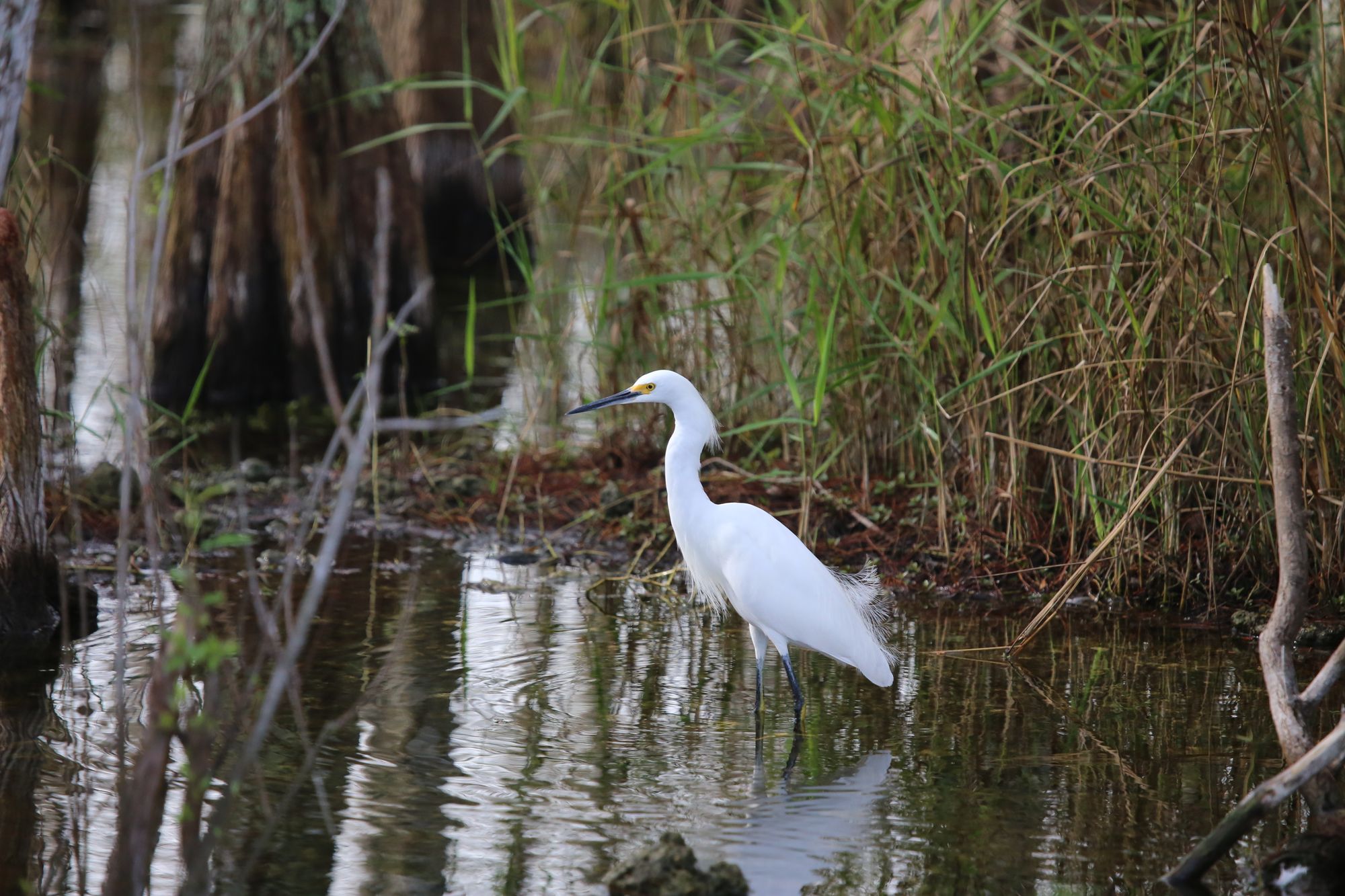
Learning to Differentiate Florida Wildlife Using the Small Details
What are these feet? To readers from Florida, they should be rather familiar. A bird with black legs and distinctive yellow feet, it is a mainstay of Backyard Florida: the snowy egret, Egretta thula. We have a plethora of wading birds here, but this can cause problems with trying to identify a particular individual. This time, I’m going to be focusing on some of the subtle characteristics that can help you distinguish between our frequent long-legged visitors. For the snowy egret, you might think that the yellow feet would be a dead giveaway, but it tends to forage in shallow water, so the feet are often obscured from view, like in the image below.

How then do you tell it apart from similar white wading birds? The great egret, Ardea alba, is considerably larger at 1 meter in height compared to 0.6 meters for the snowy. However, as I learned early on when making observations of birds in nature, size differences are not always useful as a form of distinction, especially if the subject is far away and there are no points of reference. Unless you have both species standing next to each other, it becomes difficult to perform a size comparison. However, there are other ways.

Take these most recent two photos. Neither has a good reference point for size. Both birds have dark legs and white plumage. It could be easy to confuse them for each other. But, take a look at their bill coloration. The top picture, the snowy, has a black bill, while the great egret’s bill is orange. If you venture into south Florida, there’s also an occasionally rare curveball to this duo, an all-white morph of the great blue heron, Ardea herodias. The bill coloration and overall size is almost identical to the great egret, but its legs are a light orange, compared to the black legs of the other two.
Next up, we have a pair of small herons with some striking similarities. The tricolored heron, Egretta tricolor, and the little blue heron, Egretta caerulea, are similar in size to the snowy egret. The juvenile of the latter is also all white. The adults have a similar plumage pattern and they both have two-tone bills with a black tip. The other color of the bill can sometimes be a telltale sign, yellow for the tricolored and blue for the little blue (if the beak has a black tip with a pink bill, it’s probably the larger reddish egret, Egretta rufescens). However, these colors are on a spectrum and can both range towards gray. Furthermore, the leg color is not always uniform between individuals of the same species either.
The best way to distinguish between them is the white stripe down the front of the neck as well as the white breast seen on the tricolored heron. There is no white plumage on an adult little blue heron. In addition, there are actually some behavioral differences that can clue you in. Most herons and egrets stalk their prey and then strike with lightning quickness. Tricolored herons, on the other hand, have adopted a slightly more active approach to hunting and will occasionally even run in pursuit of their prey. If you notice this particular behavior, it’s a unique method that you won’t see being used by other species.



The final pair of birds we’ll look at are much more active at dusk or later and because of this are called ‘night herons’. The black-crowned night heron, Nycticorax nycticorax, is a widespread bird throughout the world. In addition, in Florida, we can see its close relative the yellow-crowned night heron, Nyctanassa violacea. These two present another challenge.
The have identical eye color, a distinctive red, bill color, and leg color and similar size and plumage. The main difference is, of course based on the names, the color on the top or crown of their heads. But what happens if you don’t have a good vantage of that part of the bird? There are a few other distinguishing features. The body of both is almost uniformly gray, but the wings of the yellow-crowned night heron are speckled while the black-crowned night heron has solid dark patches. These are visible as the back of the bird when it is on the ground. The yellow-crowned night heron also has a white or light-yellow cheek patch on its head, which is otherwise completely black (except for the crown). The black-crowned night heron has a lighter face with a dark stripe in front of the eye.

When observing the natural world, always try to think outside the box. Sometimes, it’s the more subtle aspects of an individual species that differentiate it from other, similar ones. Take a look at these pictures, then go out and look up more photos of these species. Appreciate how much each individual has unique visual differences. It can be easy to forget this as we compare these species to humans, but the individual differences in appearance for non-human animals can be just as striking.
Our trip through the Florida Backyard is almost at a close. I hope that it’s been and interesting and satisfying journey for all of you. I always learn something new when doing my initial research for these stories and I try and impart that feeling of amazement and wonder to you. Sometimes, I even gain new insight into a species that I used to take for granted. That has been especially true for Backyard Florida as I have focused more on plants than ever before. I do not regret that focus at all. Even though they are not my research specialty, plants have their own inner workings that are so different from animals, which makes them a potentially fascinating object of study.